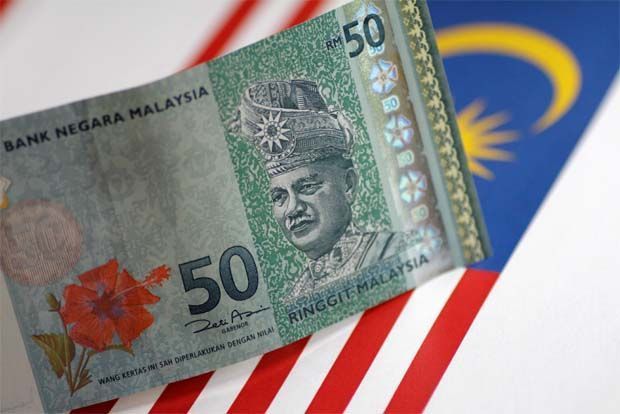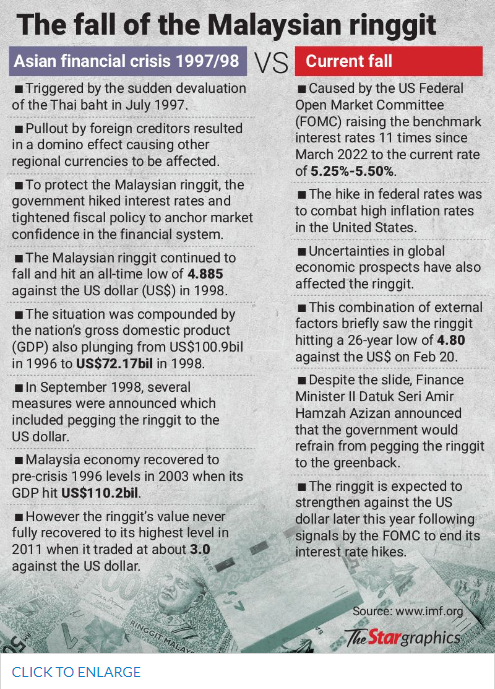The other side of the slide: Some sectors can benefit, say experts
PETALING JAYA: Manufacturers and small and medium enterprises (SMEs) are concerned with the fall of the ringgit and have called for policies to offset the impact.
However, all is not lost as export-oriented companies and the tourism sector may stand to reap benefits, say industry experts.
ALSO READ: OPR hike risks burdening the people, says Fahmi
Federation of Malaysian Manufacturers Tan Sri Soh Thian Lai said that although manufacturers here have been able to attract large jobs to manufacture high-end semiconductors and electric vehicles for export, the weakened ringgit meant a higher cost for imported materials.
Capital investment and industrial upgrading have also slowed.
One way to offset this, he said, was to reduce the reliance on the US dollar for trade while increasing the use of the ringgit.
“Companies are exploring the use of alternative currencies for imports and exports with the Chinese renminbi being the top choice, followed by the euro and Japanese yen,” he said.
ALSO READ: Ringgit to recover in value due to ongoing structural reforms, says economist
However, Soh said manufacturers are still bound by the choice of currency requested by foreign buyers and suppliers.
As such, he said there must be specific bilateral and regional cooperation on the use of alternative currencies for trade.
“The agreements by Malaysia with China, Indonesia and Thailand to encourage more trade and investment transactions in the ringgit are a step in the right direction,” he added.
Soh said it was also crucial for the government to create a business-friendly regulatory environment to keep industries competitive, adding that a “Buy Made-in-Malaysia” promotion would help local manufacturers weather the storm.
SME Association of Malaysia president Ding Hong Sing said the government must introduce clear policies on how to offset the impact of the weakening ringgit.
ALSO READ: Bank Negara: Ringgit’s current level doesn’t reflect Malaysian economy’s positive outlook
“The biggest problems faced by SMEs are their heavy reliance on imported materials which are purchased in US dollars.
“Many have to face higher import costs and have seen their profit margins dropping,” he said.
However, Ding opined that there was a silver lining, as the lower ringgit translates into better export opportunities, with exports rising by 8.7% in January this year.
Ding said it was crucial for the government to aggressively promote Malaysian-made SME products in the international market.
“This is because we have to compete with exports from countries such as Indonesia, Vietnam, Cambodia and China,” he said.
He added that the government could also decrease reliance on imported products, especially food items.
The cost of imported onions has gone up by 60% while the poultry industry has been suffering the cost of animal feed, he said.
“We have a lot of land and should encourage our youth to get involved in the agriculture sector. This could also be extended to poultry farmers to encourage them to grow corn as chicken feed,” he said.
While businesses that rely heavily on imports for manufacturing and operating processes are likely to feel the strain, Prof Dr Mohd Nazari Ismail of Universiti Malaya said that the tourism industry and related sectors are likely to thrive.
“The best example of a sector that will benefit from the low ringgit is the tourism sector. The weak ringgit will see an influx of tourists who will find it cheaper to holiday in Malaysia,” he said.
Export-oriented sectors that rely a lot on local input will also benefit because it would result in improved competitiveness.
“Their products will be less expensive (in the international market) compared to competitors and many are SMEs,” he added.
However, agricultural and poultry sectors that import a lot of fertilisers and animal feed would be among those hardest hit by the weak ringgit.
“For some large manufacturers, such as the MNCs (multinational companies), the ringgit’s fall is not an issue because they transact in US dollars.”
The ringgit has hit a 26-year low as emerging Asian currencies weakened against the dollar, trading at RM4.79 to the US dollar and RM3.57 to the Singapore dollar yesterday.
Nicholas Chia, a macro strategist at Standard Chartered, said the ringgit weakened by as much as 0.2% to its lowest level since January 1998.
Previously, Finance Minister II Datuk Seri Amir Hamzah Azizan had said he expected the ringgit to strengthen against the US dollar as the US Fed has signalled the end of interest rate hikes after raising rates 11 times since March 2022.
Economist Dr Geoffrey Williams said companies that earn income in foreign currency abroad can repatriate higher profits at a better exchange rate.
“Exports will also be cheaper, which should help companies with international sales, in the face of lower demand,” said the Malaysia University of Science and Technology professor.
A weaker ringgit would also reduce demand for imports and make domestic alternatives more attractive, including domestic tourism, he added.














Leave a Reply